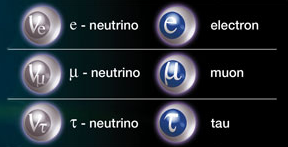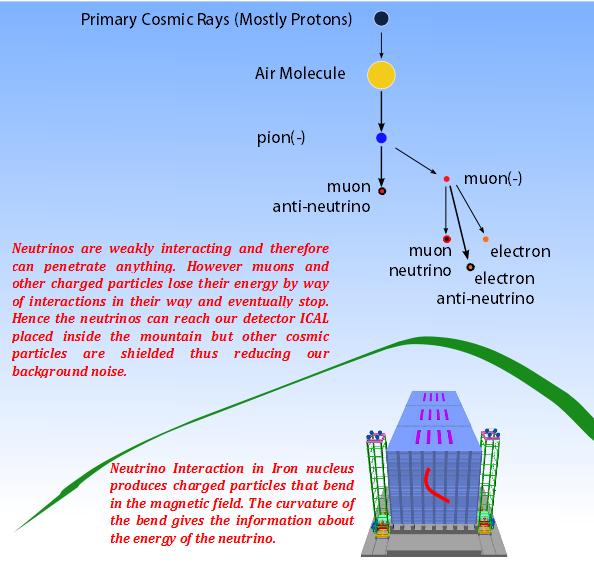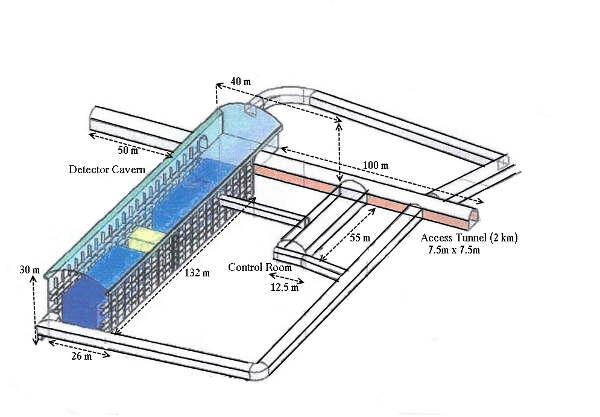About neutrinos

We know that all things in this world are made of atoms. An atom has a nucleus in its centre around which electrons go around. Inside the nucleus there are protons and neutrons. Neutrinos are tiny elementary particles like the electron but not part of the Atom. An elementary particle is one which cannot be broken into further smaller pieces. Though the words neutron and neutrino almost sound similar, they are entirely different particles. Neutrinos are represented by the greek leer ν (nu). Scientific discoveries in the past have found out that there are two more particles similar to the electron called as the muon and the tau. The muon is 200 times heavier than an electron and the tau is 3500 times heavier than the electron. Each of these three particles have a neutrino partner called the electron neutrino, muon neutrino and the tau neutrino. The electron, muon and the tau are all negatively charged particles but all the neutrinos are chargless (neutral) and are almost massless. The group of these six particles is called leptons.
Where are neutrinos produced?
Neutrinos are abundantly found in nature. The Sun, the stars and the atmosphere produce millions of neutrinos
every second. Most of these neutrinos pass through our body and we do not realize it. They can even pass through the earth and come out on the other side. The reason they can do this is because they interact very less with anything that come in
their path. In simple words, an interaction is something that changes the property of the particle like its speed, direction
etc. For example, light rays from a torch cannot penetrate a wall because particles of light interact with the wall and get
scaered before they can get to the other side of the wall. Since neutrinos interact very weakly, they are harmless.
Neutrinos can also be made artificially. They are produced in radioactive decays and in nuclear reactors.

Neutrino oscillations
Though neutrinos are found in abundance, due to their weakly interacting nature, studying these particles in the
laboratory is extremely difficult. In spite of it, Scientists have devised methods to detect these particles and to study
them.Neutrinos were initially thought to be massless particles but recent experiments suggest that they indeed
have a very small mass. These experiments found an important discovery about neutrinos. They discovered that neutrinos change from one type to another as they travel. For example, an electron neutrino that is produced in the Sun converts itself into a
muon neutrino or a tau neutrino on its flight to the earth. This conversion is called as neutrino oscillation.
It was the discovery of this property of neutrino oscillation that suggested that neutrinos have mass.Neutrino oscillation not only happens in neutrinos produced in the Sun, they happen in all the neutrinos irrespective of
where they are produced. The fact that neutrinos have mass has implications on the current understanding we have about the Universe and in sciences like Nuclear Physics, Particle Physics, Astro Physics and Cosmology. This makes the study of neutrinos a very interesting domain in scientific research. The 2002 Nobel Prize for physics was awarded to research related to Neutrinos.

India-based Neutrino Observatory
The discovery of neutrino oscillations is just a first step and there are several questions that are still unanswered. The
field of neutrino physics has aracted world-wide aention and there is a need to understand many questions put forth
by the phenomena of neutrino oscillations. The Super-Kamiokande neutrino observatory in Japan, Sudbury Neutrino Observatory in Canada, Gran-Sasso Lab in Italy, IceCube Neutrino Observatory in the South Pole are some of the existing neutrino laboratories. A few years ago an initiative began to take shape leading to the idea of the India-based Neutrino Observatory (INO), a modern world class laboratory in India for studying neutrinos.
The INO project has been marked as a Mega Science Project in the 11th 5 years plan.
The ICAL detector and the experiment
In the first phase INO will construct a detector to detect neutrinos that are naturally produced in the atmosphere.
Since there are particles other than neutrinos that are produced in the atmosphere, it would be difficult to identify
and separate signals produced by neutrinos from the signals produced by the other particles. One way to avoid the other
particles from reaching the detector is to keep the detector inside a mountain. Since neutrinos can easily pass through anything, they will reach the detector while the other particles will be filtered out by the rock in the mountain.
The detector is called Iron Calorimeter (ICAL) which is shown in the picture below. The dimension of one module of the detector is 16 m×16 m×14.5 m. It will consist of detectors called Resistive Plate Chamber (RPC) arranged in a stack of about 150 layers. Iron plates will fill the spaces between the layers. Over 30,000 RPCs will be used in this detector. A total of over 3.6 million channels will carry the electronic signals from these RPCs to be finally stored in a computer. Current carrying coils through the detector will produce a magnetic field, magnetizing the entire detector. This is a massive detector weighing 50 ktons and would be the world’s largest electromagnet. Just as a telescope observes the sky through visible light, the ICAL will observe the sky through neutrinos.
How does ICAL measure neutrino oscillations?

The ICAL detector being shielded from the cosmic ray particles (apart from neutrinos), by the rock above and on its sides and the earth below, will thus detect only neutrinos produced in the Atmosphere. The mechanism by which the neutrinos are produced in the atmosphere is shown in the picture above.

Primary cosmic rays are the main sources of atmospheric neutrinos which contain mostly muon neutrinos and electron neutrinos in the ratio 2:1. The probability of a neutrino oscillating from one flavor to another depends on the distance the
neutrino has traveled L and on its energy E. The neutrinos coming from the top the earth, having traveled less distance to reach the detector, have a lesser probability to oscillate into another flavor than the neutrinos that travel through the earth to reach the detector. Thus a measurement of the ratio of the neutrinos coming from the top to the neutrinos coming from the bottom is a direct measure of the oscillation probability.
Site location and facilities
INO will build two caverns inside a mountain. One to house the detector (26m(width) x 30m(height) x 132m(length)) and the other to house the computers and other devices controlling and monitoring the detector. Considering the geological and seismic factors, scientists have recommended that the stable and dense rocks found in the Western Ghats of Tamil Nadu are suitable for making such caves. The proposed observatory will be located in West Bodi Hills in Theni district, which is about 110 km from Madurai in Tamil Nadu. Two caverns will be made inside this hill and a tunnel of 2 km will connect these caverns to the
portal outside the hill. Outside the hill, surface facilities like housing for scientists, engineers and other workers, hostel for students, labs, offices and workshops will be constructed in the available land.
View Larger Map

Outreach Materials
Benefits
The INO project will benefit the entire country by enhancing its scientific manpower. INO requires and employs state-of-the-art technologies in its design and development. This would produce a generation that would be building up a technologically stronger nation. The detectors used in INO also find use in fields such as Medical Imaging. A project of this kind would merge various disciplines and in turn benefitting the human kind. INO will require a substantial investment in human resources. It needs a large number of physicists and engineers who will ultimately be the backbone of INO and contribute to its success. A number of universities and research institutes in India are already part of the INO Collaboration.
The collaboration at the Tata Institute of Fundamental Research is currently leading the research in the fabrication and study of RPCs and in the development of the related electronics. The teams at the Bhabha Atomic Research Centre in Mumbai and the Variable Energy Cyclotron Centre in Kolkata are focussed on the development of the magnet for the experiment. INO has recently started a graduate training school, leading to Ph.D, to train students in the various disciplines of neutrino research, The students aend course-work for a year and later go on for research work at various collaborating institutes. Visit our site for more details.
